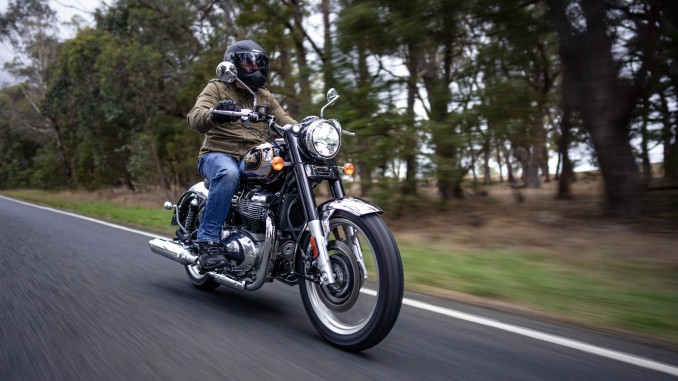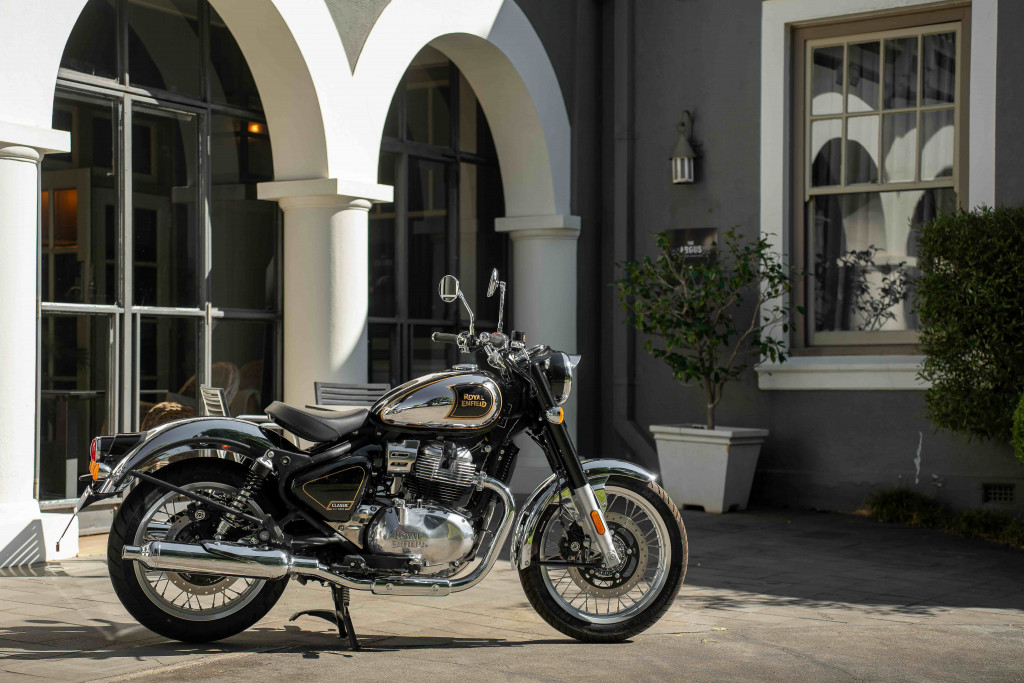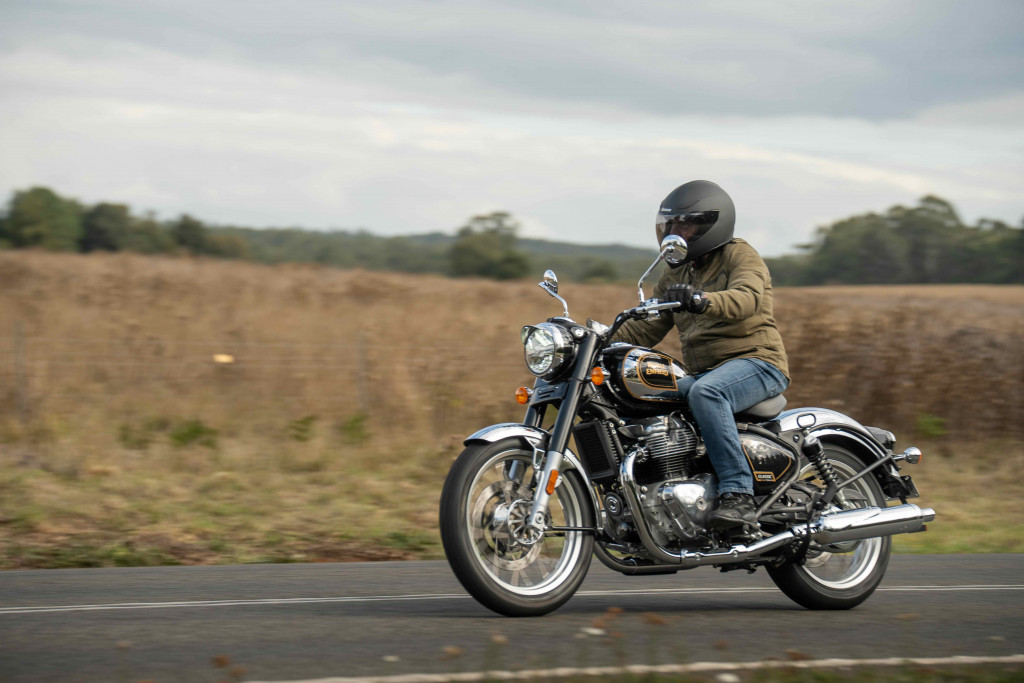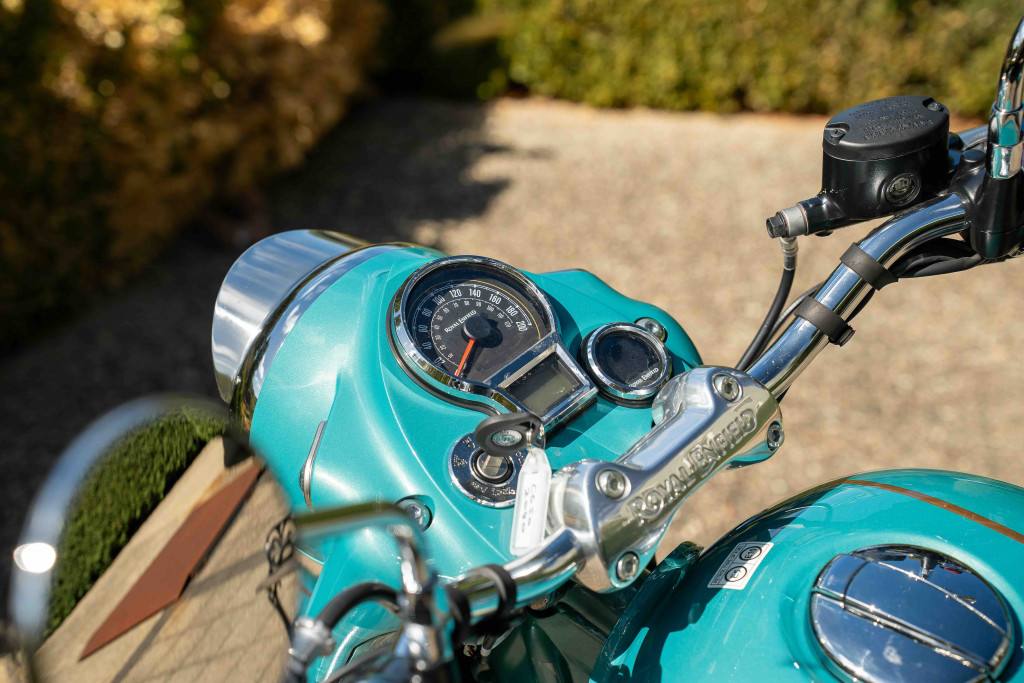
The midsize bike that Royal Enfield should have introduced at the beginning of the 650 twin story: the Classic 650.
PHOTOS: TOM FOSSATI AND MATTHEW HAYMAN
Following on from the launch of the revised Classic 350 earlier this year, Royal Enfield has introduced what many have long considered to be the missing link in the brand’s midsize parallel twin line up – the Classic 650.
At launch, the Classic 650 is more affordable than many expected, starting at $11,190 ride away for the base Vallam Red colour, $11,390 for the Teal Green and $11,890 for the Black Chrome. All are well equipped with standard Tripper navigation, standard pillion seat and frame, and standard centrestand. Oh, and a whole lot of style.
The introduction of a Classic 650 to RE’s midsize 650 range was always a no-brainer; after all, Royal Enfield has long been synonymous with reviving old design themes and the recent launch of the Classic 650 underscores the brand’s commitment to blending its heritage aesthetics with modern performance.
Drawing inspiration from the Classic 350 single, the Classic 650 twin aims to offer riders a similar blend of nostalgic charm but with more impressive open-road performance. When it comes to styling cues, there are distinct similarities between the Classic 350 and the Classic 650, but it’s the latter — along with the Super Meteor and Shotgun 650 — that features a frame shape that harks back to the post-war Bullet, a bike that remained in production for some 60 years.
RUNNING GEAR
At the heart of the Classic 650 is the same character-laden and LAMS-compliant 648cc air/oil-cooled parallel twin with 270﹉ crank that also sees duty in the aforementioned Super Meteor and Shotgun 650, as well as in the Interceptor 650, Continental GT and Bear 650. And while the engine might only muster a modest 34.6kW at 7250rpm, torque peaks at a reasonable 52.3Nm at 5650rpm, and there is plenty of grunt much further down the rev range, which makes riding any of the 650s a breeze.
A six-speed gearbox is common across the 650 line-up and Royal Enfield says the gearing of the Classic 650 is the same as that used on other 650 models, despite some hefty weight differences; the Classic tips the scales at 243kg (kerb) which is up slightly on the Super Meteor and Shotgun, and up significantly (by 41kg) on the Interceptor.
Like the Shotgun 650, the Classic scores a solo rider’s seat and a removable pillion seat that mounts to a removable rack; the latter is attached by four bolts, so it’s a little involved but not a huge operation to go from solo setup to dual.
Unique styling aside, the other big differences between the Classic 650 and the Super Meteor and Shotgun 650 include the riding position, wheel sizes, seat height and the seat.
The Classic has a neutral riding position with upright ergos and mid-mount footpegs, and while those ’pegs feel like they’re in pretty much the same position as those on the Shotgun, there is less of a stretch to the handlebar which closes up the rider triangle somewhat. Having said that, the Classic’s 800mm seat height is 5mm higher than the Shotgun’s (probably as a result of the different wheel sizes) and it’s significantly higher than the Super Meteor’s, which has a low 740mm seat and forward-mounted footpegs for a more relaxed cruiser-style riding position.
Those wheels on the Classic are a 19/18inch wheel combo with MRF rubber in a 100/90-19 up front and 140/70-18 at the rear. That’s the same front tyre size as the Super Meteor, but with a 17-inch rear instead of a 16, while the Shotgun runs an 18-inch wheel up front and a 17-inch wheel at the rear with a slightly wider 150 section tyre.
The result of these variances in weight, riding position and wheel/tyre sizes (as well as different springs and damping rates) is that all three bikes have a unique feel to them on the road.
LASHINGS OF CHROME
Before we get to the riding impressions, let’s back-pedal a bit and revisit the aesthetics. While I’m not a huge fan of the standard Vallam Red or Teal Green colour schemes, the Royal Enfield designers have nailed it with the Black Chrome which, in my opinion, best complements the overall shape of the bike.
The black and chrome finish really emphasises the teardrop shape of the fuel tank, which is adorned with hand-painted gold pinstripes. There are lashings of chrome everywhere which are complemented by the polished engine cases. It really is a classic look befitting of a bike called Classic.
If Vallam Red does take your fancy, you get a cool “Royal Enfield” script on the fuel tank, and if you like Teal Green, you’ll get plenty of it: on the tank, the frame, the mudguards, the fork covers, the side covers, the headlight casquette, and even on the sidestand and the standard-fit centrestand.
No matter which colour you opt for, you get that groovy chrome peak over the round headlight, super-trick chrome-finish switchblocks, and LED lighting all around including the indicators.
SO HOW DOES IT GO?
Due to time constraints on the launch, the test ride was well short of what I was expecting or hoping for as I had been quite keen on throwing a leg over the Classic 650. Nevertheless, I got to sample the bike on a mix of roads including some around town (country town, that is) stuff, on some twisty back roads of varying quality and even a short freeway run.
As mentioned, the 648cc parallel twin is no powerhouse, but with a broad spread of torque from low in the rev range and through the midrange, and spot-on fuelling with no pauses or hiccups from closed to open throttle, it offers a fun riding experience that doesn’t require a lot of input from the rider. You can be lazy with the progressive clutch and slick-shifting six-speed ’box and just rely on the engine to pull you out of corners without resorting to a downshift if that’s how you want to ride it, or you can work the ’box a bit and eke a little more from the engine. Either way, there’s not a hell of a lot of reason to explore the upper reaches of the rev range as the twin responds best to short shifting. Having said that, you may occasionally want to rev it just to hear the tasty exhaust note which, although muffled through the twin chrome peashooters, is still loud enough to entertain when you crack open the throttle.
When you want to haul up the Classic or just brush off some speed for a corner, there’s better braking performance than you might expect considering the Classic’s 243kg kerb weight and the single 320mm disc up front. That front disc is gripped by a twin-piston floating caliper, while there’s an effective 270mm disc at the rear with a single-piston floating caliper. Both brakes offer good feel and the rear brake is particularly effective when you want to tighten your line mid-corner or trail brake through roundabouts or tight turns. The front brake lever is span adjustable, as is the clutch lever.
Over bumpy sections the Showa suspension felt firmer than I was expecting from this style of bike, and while you might think this would result in a sporty character, the overall weight of the bike, the lazy steering geometry and the 19-inch front wheel slows things down a bit when you get into the bends. Beneath those cool-looking fork covers, you won’t find any adjustment on the 43mm telescopic fork, but the twin rear shocks are adjustable for preload, which is good given that the pillion seat is supplied as standard in Australia with the Classic 650 (it is optional in some other markets).
The weather was a bit iffy on the launch ride and there were several damp patches along the route as well as some completely wet roads, which gave a good opportunity to get a feel for the MRF NyloHigh tyres, which worked well in all conditions encountered. That inspired enough confidence to hook into a few bends at speed and while there’s reasonable ground clearance when cornering, the mid-mount ’pegs did scrape a couple of times on some tighter turns… but you really have to be pushing it to get this to happen and I doubt that spirited riding like this will be in this bike’s remit for most buyers.
After a couple of hours in the saddle I had no complaints regarding comfort. In fact, the seat is supremely comfortable — it is generously wide and so well padded that I would like to find out who supplies the cushioning so I can order it in my next lounge suite. The aforementioned neutral riding position also helps in the comfort stakes, although the wide handlebar and lack of a screen means you can cop a fair old wind buffeting at highway speeds.
TECH AND FEATURES
The instrument cluster atop the headlight combines an analogue speedo with an LCD display for odo, trips, tacho, fuel and gear position, while Royal Enfield’s Tripper is standard on the Classic 650 for turn-by-turn navigation using your phone. There’s a USB-C charging port up near the left-side handgrip to keep your phone juiced up.
There’s a basic dual-channel ABS system, but other than that there are no electronic traction aids or ride modes, not that tech like this is really needed on a 35kW midsize bike that’s as forgiving to ride as the Classic 650.
With a 14.8L tank capacity and assuming fuel consumption will be similar to the Shotgun 650 of around 4.7L/100km, the Classic should have a touring range close to 300km, which will be plenty for most wanting to escape for a weekend ride.
SHOULD YOU BUY ONE?
The Royal Enfield Classic 650 successfully bridges the gap between vintage charm and modern functionality. For those who love a bit of nostalgia but who don’t want to put up with all the maintenance and potential dramas of buying a genuine vintage bike, the Classic 650 offers a soulful and engaging experience, wrapped in a package of timeless elegance. And it’s covered by a three-year unlimited-kilometre warranty with three years roadside assistance.
While it might not boast the high-tech features of some contemporaries, its simplicity, character and affordability will make it a compelling choice for riders looking for a back-to-basics experience, whether they are just beginning their motorcycling journey or are an old hand on two wheels.
SPECIFICATIONS
Royal Enfield Classic 650
ENGINE
Type: Parallel twin, 4 stroke, SOHC, air-oil cooled
Capacity: 648cc
Compression ratio: 9.5:1
Engine management: EFI
PERFORMANCE
Claimed maximum power: 34.6kW (47hp) @ 7250rpm
Claimed maximum torque: 52.3Nm @ 5650rpm
Fuel consumption: N/A
TRANSMISSION
Type: 6-speed constant mesh
Final drive: Chain
Clutch: Wet multiplate
CHASSIS AND RUNNING GEAR
Chassis: Steel tubular spine frame
Front suspension: Showa 43mm telescopic fork
Rear suspension: Showa twin shock, 90mm travel
Front brakes: Single 320mm disc, twin-piston floating caliper, ABS
Rear brake: Single 270mm disc, single-piston floating caliper, ABS
Front tyre: MRF NyloHigh, 100/90-19 M/C
Rear tyre: MRF NyloHigh140/70-18 M/C
DIMENSIONS AND CAPACITIES
Rake: 25.3°
Trail: 101mm
Claimed kerb weight: 243kg
Seat height: 800mm
Wheelbase: 1466mm
Fuel capacity: 14.8L
ELECTRONICS, RIDER AIDS & CONVENIENCE FEATURES
ABS, LED lighting, Tripper Navigator, combination digital/analogue instruments, USB-C charger, removable passenger seat/rack combination
ETCETERA
Price: From $11,190 ride away
Colours: Vallam Red ($11,190), Teal Green ($11,390) and Black Chrome ($11,890)
Test bike supplied by: Royal Enfield Australia
Website: https://royalenfield.com.au/model/classic-650/
Warranty: 3 years unlimited kilometres + 3 years roadside assistance











